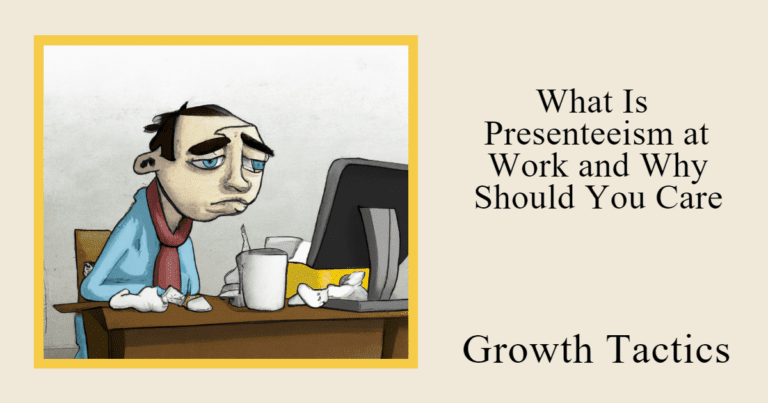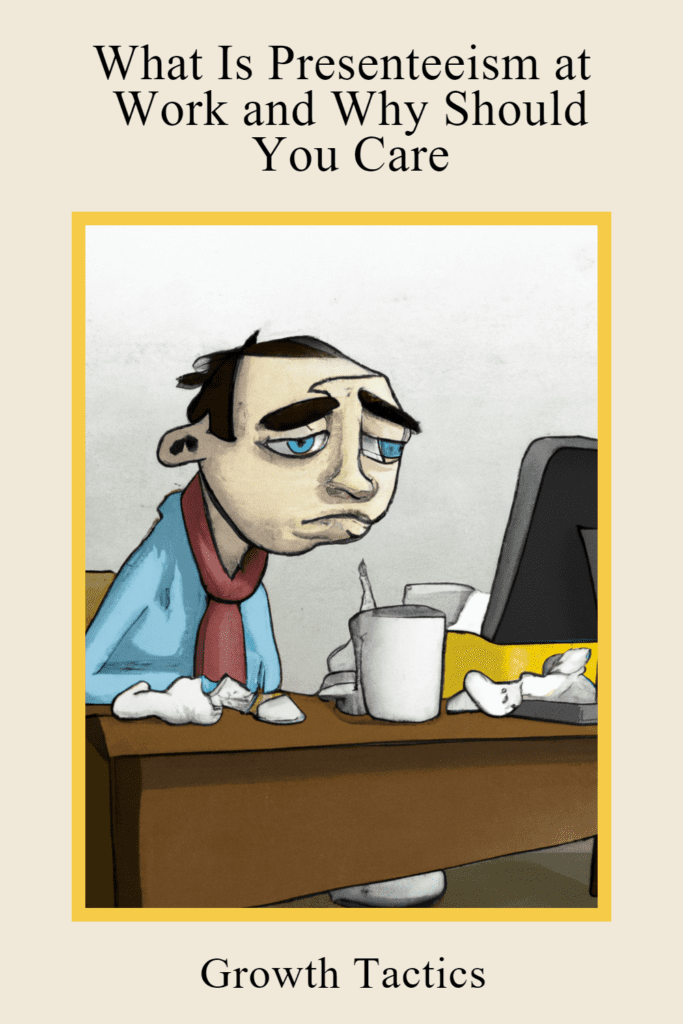Do you know what presenteeism at work is and why it should be a concern for both employers and employees? Presenteeism is the act of being physically present in the workplace, but not actually productive. It has become increasingly common in the modern workplace, yet many people remain unaware of its implications.
This article will explain what presenteeism is, the causes behind it, and why it should be a priority for both employers and employees to address. By understanding what presenteeism is and its impact on productivity, morale, and health, businesses can better manage employee performance and create a healthier work environment.
Jump To Section
What Is Presenteeism?
Presenteeism is the term used to describe the act of coming to work despite feeling unwell. It can be caused by an illness, but can also be caused by conditions that make it difficult for someone to carry out their normal duties at work. This can lead to lost productivity and reduced efficiency in the workplace.
There are various costs associated with presenteeism. Employees who are absent due to illness or other medical conditions can lose wages and benefits, while businesses often have to spend more on staff replacements and other costs associated with presenteeism. In some cases, presenteeism can lead to fully-functioning employees becoming disabled due to their condition.
Combatting presenteeism is an important part of improving workplace productivity. Measures that are taken to reduce the incidence of illness or other medical conditions in the first place will also help reduce presenteeism. Employees need to be made aware of the importance of coming to work when they are well, and risks need to be discussed openly so that everyone is aware of what should happen if someone fails to show up for work.
How to Detect Presenteeism in the Workplace?

Detecting presenteeism, where employees show up but aren’t fully productive, requires a keen eye and proactive leadership. Let’s break it down.
Check Attendance Records
Start with attendance. Is someone showing up but not really contributing? Patterns of frequent, unexplained presence can be a sign. Look deeper; attendance is more than just being physically present.
Monitor Communication
Observe the communication flow. Notice if employees are engaging less in conversations or team activities. Reduced interaction can often mask underlying issues. Open dialogue fosters connection and productivity.
Measure Work Output
Assess the output. Even if they are present, are they meeting their goals and contributing effectively? Low performance amidst high presence can be a clear signal of presenteeism. Numbers don’t lie, so let the work speak for itself.
Foster Open Communication
Most importantly, talk to your team. Regular and genuine conversations build trust and openness. Encourage them to share challenges. Understanding personal struggles can often reveal the roots of presenteeism, allowing you to provide the necessary support.
How Does Presenteeism Impact the Workplace?
Detecting and understanding presenteeism within your organization is paramount to maintaining a productive, healthy, and engaged workforce. Here’s how this hidden challenge affects your team and bottom line.
Financial Toll
Presenteeism is costly. Employees who show up but aren’t fully contributing drain your resources. This hidden expense impacts your bottom line through lost productivity and wasted wages. Addressing it is crucial for maintaining financial health and operational efficiency.
Health Consequences
The next layer is health. Presenteeism often brings sickness and stress into the workplace. Employees pushing through their limits face long-term repercussions such as burnout and increased sick leave, harming both individual well-being and the team’s overall morale.
Employee Turnover
A disengaged workforce tends to leave. Presenteeism can drive up employee turnover, disrupting operations and eroding team cohesion. High turnover also carries the additional cost of recruiting and training new staff. Retention requires vigilance and a proactive approach.
Education and Prevention
While there’s no magic solution, education is powerful. Engage your team in discussions about the impact of presenteeism. Awareness breeds understanding. Foster an environment where employees feel safe to communicate their struggles and seek support.
Why do employees practice presenteeism?
Employees often feel pressure not to take sick leave because they fear that their current position will be at risk if they are absent. Additionally, many employees are paid based on a percentage of their yearly salary, which means that taking time off for illness can significantly reduce their income. Paid sick leave could help to alleviate some of these pressures and incentivize employees to take the time they need to recover from an illness.
How to Reduce or Prevent Presenteeism?
Many employers and employees are trying to find a way to reduce or prevent presenteeism. There are many ways to reduce or prevent presenteeism in the workplace. Let’s discuss some of them now.
Recognize the symptoms

The first step in reducing presenteeism is recognizing the symptoms. The best way to recognize the symptoms of presenteeism is to ask your employees how they are feeling. If you think someone may be suffering from presenteeism, try to find out the reason why they are not feeling well. Sometimes you have to dig a little deeper and actually get to know your employees.
Encourage employees to take vacations
When employees take vacations, it can help relieve stress. This is because vacations give employees a break from the everyday routine and allow them to appreciate what they have. Vacations also allow employees to recharge their batteries and come back with a fresh perspective. Taking vacations can be a great way to keep employees energized and motivated throughout the year. This can be a big help in preventing presenteeism.
Maintain a standard of productivity
Maintaining a standard of productivity is important to avoid presenteeism. If employees feel like they have to come to work even if they are not productive, it can lead to burnout and overall poor performance. It is important to set goals and expectations for oneself and others to maintain a level of productivity and to have systems in place to track progress.
Allow employees to make up work later
Allowing employees to make up for work they may have missed is a great way to show that you care about them and their jobs. This can help to prevent any tension or resentment from building up, and will generally make everyone much happier.
Let your employees go home
It is always important to try and let your employees go home as much as possible, to allow them to relax and recharge. This can help them work more efficiently in the future, and also ensure that they are well-rested when they are needed most. If you have the ability and all the work is done, don’t keep employees just because they haven’t hit their hours.
Encourage healthy living

The benefits of a healthy lifestyle are clear. Reduced stress levels, a healthier immune system, and a longer lifespan are just a few of the many benefits of living a healthy lifestyle. It is important to remember that it is not always easy to maintain a healthy lifestyle, but the rewards are well worth it.
Some simple ways to encourage healthy living include: adopting healthy eating habits, getting enough exercise, and avoiding temptation. By choosing to live a healthier lifestyle, we can all make significant improvements in our overall health and well-being.
Add mental health support to your benefits package
Mental health is an essential part of overall health, and it should be included in any benefits package. This support can help employees feel better prepared to handle stressors in their work lives and home lives, which can lead to better overall mental health. When employers provide this support, employees are more likely to seek out medical attention if they experience a mental health issue and take advantage of mental health resources available through the company. In addition, providing mental health support can help employers better understand their employees, which can lead to improved relationships.
Offer flexible work arrangements
There are a variety of different flexible work arrangements available to employees, depending on their needs and preferences. These arrangements can include things like working from home, being able to telecommute, flexible hours or having the ability to work from another location.
These types of arrangements can help employees save time and stay productive. They can also help companies reach their goals by freeing up resources so that employees can focus on other tasks. Flexible work arrangements are an important part of today’s workforce, and they should be available to all employees if the company’s goals can still be achieved.
Focus more on results, not hours
Results are what matters, not hours. Encourage employees to work hard and be efficient, but not to sacrifice their quality of life for the sake of a few extra hours in the day. When it comes to work-life balance, remember that the key is finding a happy medium. Try to focus on your results and ignore hours worked. This way employees can enjoy their life and still achieve goals.
Reduce large workloads
Large workloads can be a burden when trying to keep up with deadlines. By minimizing the number of tasks that need to be completed, it will allow more time to focus on the important items. Try to break down larger projects into smaller goals so that they can be completed with less effort. Additionally, establishing better communication and collaboration between team members will help ensure that tasks are completed promptly.
Encourage open communication
Encouraging open communication between team members is key to a productive work environment. It allows for quick problem resolution and prevents misunderstandings that can lead to conflict. By being open, you build trust and respect within your team, which will lead to greater success.
Conduct staff surveys to determine the current status
Conducting staff surveys is a great way to get an idea of the current status of your organization. By understanding what employees are currently experiencing, you can improve your working environment and ultimately make your organization more successful.
Set reasonable expectations
Everyone has different expectations, so it is important to set reasonable ones from the get-go. If you don’t know exactly what you are looking for, it can be difficult to judge when something is good enough. This can lead to frustration and a decreased likelihood of satisfaction. Set some reasonable guidelines and stick to them, and you’ll be well on your way to successful leadership.
Set the example
It is important to set an example for others to follow, especially as an individual in a position of influence. It can be easy to get wrapped up in our world and forget about the impact that we have on others. It is important to be aware of the things that we say and do and make sure that our actions reflect the values that we hold dear.
Wrapping It Up
The fact of the matter is that presenteeism is a problem, and it can have a detrimental effect on productivity. Whether you’re an employer looking to boost workplace morale, or an employee looking to work more productively, presenteeism should be carefully managed.
In addition to providing adequate resources, both employers and employees must ensure that they maintain a healthy sense of pride within their organization. Employees must also be careful not to neglect their time with family or friends for unnecessary overtime.
Ultimately, employers and employees can only benefit from a healthy relationship by maintaining a strong sense of pride in their organization, good working relationships, and a balanced life outside of work.
Did you find this article on presenteeism useful? Don’t forget to share and subscribe below.


